NEONATOLOGY ON THE WEB
The Nursling
Lecture 3
By Pierre Budin, Professor of Obstetrics, University of Paris; Director
of the Clinique Tarnier; Member of the Academy of Medicine, Paris, France. Authorized
translation by William J. Maloney, M.B., Ch. B., 1907.
Gentlemen,
In the previous lecture we were discussing the feeding of
weaklings. I pointed out the importance of adjusting the quantity of
milk absorbed, and I endeavoured to fix a basis upon which the
requirements of an infant afflicted with congenital debility might be
estimated.
Feeding is indispensable to the nutrition and development of
tissues and the production of animal heat.
The food for infants is human milk; it is, with certain
exceptions, the only one which ought to be given to weaklings and
newly-born children.
The average composition per litre of human milk is --
35 grams of butter
74-75 grams of lactose or sugar of milk
12-14 grams of proteids or albuminoids
2 grams of mineral salts
This makes a total of about 125 grams of solids
Of all these substances the most important is butter. It is the
main factor in the generation of animal heat, as it is the
constituent in milk which furnishes the greatest number of calories.
One gram of butter yields 9.3 calories, and 96 per cent. of the
butter in milk is utilized by the organism.
If the number of calories representing the average alimentary
ration of an infant be calculated, it is found that 53 per cent.,
more than half, come from butter.
Butter, therefore, plays an important role in the feeding. An
infant ought to take plenty of a milk poor in butter and less of one
rich in it. I gave you examples of this in our last lecture, and I
further showed that if the milk be too fat it may cause indigestion,
and instead of the normal 4 per cent. of butter in the stools, as
much as 30 or 35 per cent. may then be found.
Butter, although of great consequence as a heat producer, is not,
however, the only nutritive substance contained in the mammary
secretion. From a commercial point of view the greatest interest
doubtless centres upon it. In cow's milk it is the constituent which
has the highest marketable value, and therefore it is liable to be
fraudulently removed. In milk, however, not only is there butter,
there are in addition sugar and proteids. These also can be oxidised;
and, as the sugar of milk furnishes 29 per cent. and the albuminoid
substances 18 per cent. of the total calories, they have a
considerable value in the production of animal heat.
These substances are destined not solely for the production of
heat but also for the formation and renovation of the tissues. This
applies particularly to the proteid matter and in a less degree to
the mineral salts.
We must remember that in every litre of milk there are 875 grams
of water. The presence of this water in milk explains what at first
seems a singular phenomenon. Certain infants, just cured of
diarrhoea, increase in one week by 400, 500, or even 600 grams in
weight. This is certainly not due to 600 grams of new tissues having
been formed in so short a time. An infant with diarrhoea rapidly
diminishes in weight owing to the loss of the fluid part of its
tissues. Once the diarrhoea is cured, this drain is rapidly recovered
from by the absorption of water from the milk. Hence the great
augmentation in weight. Water also favours the functions of certain
organs, the kidneys, for example, and by evaporation it plays an
important part in the regulation of temperature.
It seems to be proved that an infant requires 100 calories, per
kilogram of body weight, every twenty-four hours. Thus, an infant of
three kilos would need daily a quantity of nutritive material
sufficient to produce 300 calories. With tiny infants this number is
relatively greater. In proportion to their weight the surface of
their body is larger, and they thus present a more extensive area
from which heat may be dissipated.
Lastly, we must not forget, in studying the feeding of infants,
that they require not merely to be maintained as if their weight
remained stationary, but also to have a growing allowance to meet
their daily development and increase. If an infant and an adult were
fed exclusively on milk, the former would absorb, relatively to its
weight, much more than the latter, as the one has generally only to
sustain life, while the other has to provide for growth.
Milk, then, has to be given to a weakling in sufficient quantity
in order to safeguard against inanition, cyanosis, and chilling. I
have endeavoured to determine the approximate amount an infant must
take to obviate these dangers without incurring the risks of
overfeeding.
How are infants nourished in wards for weaklings such as those at
the Maternité? They are brought from the midwifery wards of
other hospitals, or from their homes, and have no longer their
mothers to give them the breast. Their feeding is entrusted to
wet-nurses, who should be allowed to keep their own infants, for if
they suckled only puny little beings, who are sometimes scarcely able
even to swallow, their milk would diminish and even disappear.
How many wet-nurses are required?
The wards are intended to receive 26 or 28 infants, but they are
usually crowded. In 1895 more than 40 infants were being
accommodated, while there was room for only 14 wet-nurses. How could
40 weaklings be fed by 14 women, each of whom was already suckling
her own child? This problem, at first glance insoluble, can be
solved. At the beginning the infants of the wet-nurses were suckled
by their mothers, and I left them at the breast exclusively for
several weeks. Then I began to give them sterilised milk, which, as
is seen by their tracings, they tolerated well.
Further, wet-nurses can supply much more milk than one might
credit. Here is how I found this out.
When I returned from my holidays on October 1, 1895, I found 50
weaklings in the cradles and incubators. To provide for their
nourishment there were only 14 wet-nurses, and they had, in addition,
to feed their own babies.
These wet-nurses had to attend to 50 + 14 = 64 infants; each of
them, consequently, had to suckle and tend either 4 or 5 (64 / 14 =
4.5). Each woman giving the breast about nine times to each infant
had thus to furnish, on an average, 40 feeds per day. This, however,
is not quite correct, for their own infants were made to take
sterilised milk. On the other hand, they were obliged to draw off
their milk to feed those infants who could not suck, or who were
suspected of syphilis, and were fed by hand. Further, they had to
wash, bath, and dress their charges, change the hot water in the
incubators, keep their own dormitory and dining-room in order,
&c. Under these conditions the 14 wet-nurses were jaded and worn
out -- the nurslings entrusted to them scarcely increased in weight,
and their own babies did not thrive.
I therefore reduced the number of weaklings from 50 to 40 by not
replacing those who left or died. Our 14 wet-nurses had still to care
for 40 + 14 = 54 infants, almost 4 infants (3.8) each, but they had
now to give not more than 34 feeds per day, instead of 40.
Thenceforth the infants of the wet-nurses improved, and the
weaklings steadily increased in weight.
Every fortnight the amount of milk given by our wet-nurses was
estimated. This was easily done. As you know, each weakling is
weighed before and after meals, and at the end of the day the
quantity it has ingested is thus readily estimated. If we added
together the quantities of milk which the wet-nurse had furnished to
those she suckled, those who had to be gavaged and fed by hand, and
her own infant, we could obtain her total milk production in the
twenty-four hours.
In the table which I now show you I have placed the quantities of
milk furnished by the seven wet-nurses who were in our service at the
end of February 1896, and had been with us from October 1, 1895.
According to these figures the milk yielded by them increased in
amount from October 1 to November 29.
Their total production on October 1 was 11,605 grams, an average
of 1,657 grams per wet-nurse. On November 29 it reached 15,620 grams,
an average of 2230 grams per wet-nurse.
|
Names
|
Oct. 1
|
Oct. 15
|
Nov. 2
|
Nov. 29
|
Dec. 10
|
Jan. 14
|
Jan. 24
|
|
Larth
|
1,340
|
1,340
|
970
|
1,545
|
1,070
|
1,240
|
1,420
|
|
Bony
|
1,590
|
1,800
|
1,955
|
2,210
|
1,880
|
1,560
|
1,590
|
|
Elra
|
2,000
|
2,040
|
2,330
|
2,320
|
1,880
|
1,470
|
1,590
|
|
Pect
|
1,400
|
1,990
|
2,340
|
2,545
|
1,800
|
1,650
|
1,670
|
|
Lequill
|
1,895
|
2,070
|
2,170
|
2,840
|
2,010
|
1,240
|
2,030
|
|
Adam
|
1,660
|
2,090
|
2,120
|
2,350
|
1,670
|
1,540
|
1,485
|
|
Thiel
|
1,720
|
1,750
|
1,780
|
1,810
|
1,530
|
1,420
|
1,500
|
|
Total
|
11,605
|
13,080
|
13,665
|
15,620
|
11,840
|
10,120
|
11,285
|
|
Average
|
1,657
|
1,868
|
1,952
|
2,320
|
1,690
|
1,431
|
1,612
|
This remarkable increase in the milk secretion of these wet-nurses
is graphically represented on the curve
(Fig. 21).
Here, then, are women who became capable of furnishing 2230 grams
of milk per day. It must not be thought that the average is based on
insufficient data, as it is founded upon statistics relating to seven
wet-nurses, one of whom, indeed, yielded as much as 2840 grams per
twenty-four hours.
What happened then? On November 26, at 5 P.M., the wet-nurses, in
spite of our remonstrances, went out with their infants in cold and
rain. Next day, three of them and nine of their little ones had
bronchitis. On making my customary visit to the weaklings that
morning I found some of them had not increased, and on seeking the
cause I discovered that the wet-nurses, to whom they were entrusted,
had been up all night attending to their own babies.
On December 3, in spite of all our precautions, the epidemic
spread to the weaklings, a great number of whom died. We did not
admit others.
The quantity of milk given by the wet-nurses was then seen to
diminish.
On December 10, it was not more than 11,840 grams for the seven,
which was an average of 1690 grams per woman.
On January 14, the total yield was only 10,020 grams, an average
of 1431 grams each.
The extremes were --
|
11,605 grams
|
October 1
|
1657 grams per wet-nurse
|
|
15,610 grams
|
November 29
|
2270 grams per wet-nurse
|
|
10,020 grams
|
January 14
|
1431 grams per wet-nurse
|
Between November 29, maximum figure, 15,620 grams, and January 14,
minimum figure, 10,020 grams, the production had decreased more than
one-third.
The wards were re-opened for the reception of new cases on
February 1, 1896. A greater quantity of milk then became necessary,
and the yield was seen to increase. On February 24, it attained
11,285 grams for the seven, being an average of 1612 grams each.
Below, we have tabulated the observations of the milk production
of three wet-nurses, who were not in our service on October 1, but
who entered it, one on October 3, and two on October 28.
|
Names
|
Nov. 2
|
Nov. 29
|
Dec. 10
|
Jan. 14
|
Feb. 24
|
|
Leje
|
1535
|
2140
|
1660
|
1030
|
2240
|
|
Menet
|
1560
|
1520
|
1480
|
990
|
1780
|
|
Mang
|
1610
|
1810
|
1650
|
1400
|
1850
|
|
Total
|
4705
|
5470
|
4790
|
3620
|
5870
|
|
Average
|
1568
|
1823
|
1596
|
1140
|
1956
|
The curve which represents these figures also rises till November
29 (Fig. 22).
From the outbreak of the epidemic, the quantity of milk required
gradually diminished.
When the wards were reopened, and infants again received, a
greater amount of milk was needed; the production, which from 1823
grams per day had fallen to 1140 grams, a diminution of more than
one-third, then rose to 1956 grams.
The average quantity of milk daily furnished by these wet-nurses
will appear to you considerable. It was a source of wonder to us
also. These women did not receive any particular or extraordinary
diet. They were excellent wet-nurses, for they gave on an average
1657, 1868, 1953, and even up to 2270 grams of milk per day.
Evidently, they were stimulated to supply plenty of milk through
plenty being demanded from them.
With a view to studying this matter more closely, I tried to trace
what had occurred from the day these wet-nurses had first entered our
service.
Since the quantity of milk taken by the weaklings they suckled was
known at the end of each day, it was only necessary to weigh their
own babies, before and after their breast feeds, in order to obtain
the total milk production in the twenty-four hours. It was found that
the quantity continued steadily to increase during a certain time.
The wet-nurse Ga_____ , for example, who was delivered July 16,
1896, and entered the department for weaklings on August 4, gave
(Fig. 23) --
|
On August 6
|
490 grams of milk
|
|
" September 7
|
910 "
|
|
" September 23
|
1450 "
|
|
" October 20
|
1640 "
|
|
" November 16
|
1900 "
|
The wet-nurse Be_____, who was also delivered on July 16, 1896,
entered the department on August 4; she furnished
(Fig. 24) --
|
On August 6
|
410 grams of milk
|
|
" September 23
|
1370 "
|
|
" October 20
|
1410 "
|
|
" November 16
|
2050 "
|
The more these wet-nurses suckled the greater quantity of milk
they yielded, so that the production ultimately attained considerable
dimensions.
Very much interested, I continued my researches. I compared the
quantities of milk which they furnished from day to day, when the
number of infants was constant, and when it varied.
The wet-nurse Den_____, delivered on May 10, 1897, entered the
department on June 5 (Fig. 25). Three
tiny infants were confided to her care. Including her own baby, she
had then four nurslings.
From June 5 to 6 she gave 550 grams of milk in 24
hours.
From June 6 to 7 she gave 1040 grams of milk in 24 hours.
From June 7 to 8 she gave 1360 grams of milk in 24 hours.
From June 8 to 9 she gave 1300 grams of milk in 24 hours.
From June 9 to 10 she gave 1700 grams of milk in 24 hours.
From June 12 to 13 she gave 1760 grams of milk in 24 hours.
The infant of the wet-nurse sucked greedily. It had some digestive
disturbance and diarrhoea, so its allowance was diminished for some
days.
From June 13 to 14 the wet-nurse gave 1630 grams of
milk.
From June 14 to 15 the wet-nurse gave 1470 grams of milk.
From June 15 to 16 the wet-nurse gave 1420 grams of milk.
From June 17 to 18 the wet-nurse gave 1580 grams of milk.
From the 18th to the 19th she let her infant take a great deal
(740 grams), so that she furnished --
From June 18 to 19 the wet-nurse gave 1930 grams of
milk
From June 19 to 20 the wet-nurse gave 1580 grams of milk
From June 20 to 21 the wet-nurse gave 1690 grams of milk
From June 21 to 22 the wet-nurse gave 1540 grams of milk
From June 22 to 23 the wet-nurse gave 1630 grams of milk
From June 23 to 24 the wet-nurse gave 1589 grams of milk
From June 24 to 25 the wet-nurse gave 1820 grams of milk
During this period this woman constantly suckled four infants; the
quantity of her milk increased rapidly from 550 to 1760 to 1930
grams, and it varied according to the demands of the nurslings; the
day on which she furnished most (1930 grams), her own infant for his
share alone took 740 grams.
Here is another observation in which the number of infants suckled
was made to vary.
The wet-nurse, Mart____, delivered May 25, 1897, entered the
department on June 11. Including her own baby, she nursed
successively two infants, then three, then four, and then three
again.
From June 12 to 13 she gave 690 grams for 2 infants.
From June 13 to 14 she gave 810 grams for 2 infants.
From June 14 to 15 she gave 800 grams for 2 infants.
From June 15 to 16 she gave 850 grams for 2 infants.
From June 16 to 17 she gave 820 grams for 2 infants.
From June 17 to 18 she gave 1000 grams for 3 infants.
From June 18 to 19 she gave 1530 grams for 4 infants.
From June 19 to 20 she gave 1750 grams for 4 infants.
From June 20 to 21 she gave 1260 grams for 3 infants.
From June 21 to 22 she gave 1030 grams for 3 infants.
One of the infants was taking 470 grams per day; it was replaced
by a smaller, which drank only 180 grams. She then yielded --
From June 22 to 23 she gave 1130 grams for 3 infants.
From June 23 to 24 she gave 1120 grams for 3 infants.
From June 24 to 25 she gave 1200 grams for 3 infants.
In proportion as the demand was greater the woman supplied more
milk; as the demand decreased so also did the amount of milk produced
(Fig. 26).
Here is another observation which is no less convincing.
The wet-nurse Al______, delivered May 25, 1897, entered the
department on June 11 (Fig. 27).
From June 12 to 13 she gave 720 grams of milk to 2
infants.
From June 13 to 14 she gave 990 grams of milk to 3 infants.
From June 15 to 16 she gave 1210 grams of milk to 3 infants.
From June 16 to 17 she gave 1240 grams of milk to 3 infants.
From June 17 to 18 she gave 1100 grams of milk to 2 infants.
But her own infant had taken the enormous quantity of 810 grams;
it had some digestive trouble, and its ration had to be diminished
(see Appendix).
From June 18 to 19 she gave 700 grams of milk for two infants.
Her infant this day was ordered only 360 grams of milk.
From June 19 to 20 she gave 1180 grams for 3 infants.
From June 20 to 21 she gave 1220 grams for 3 infants.
From June 21 to 22 she gave 1520 grams for 3 infants.
From June 22 to 23 she gave 1750 grams for 3 infants.
From June 23 to 24 she gave 1550 grams for 3 infants.
From June 24 to 25 she gave 1510 grams for 3 infants.
It is thus clearly demonstrated that the quantity of milk
increases with the demand, and diminishes as the nurslings need less,
or are less numerous.
You were able to follow in the wards, a short time ago, an
observation of the same kind, in which I predicted to you the result
(Fig. 28). A spare, feeble,
miserable-looking little woman had given birth to twins on January 14
last. She nourished one of them, called Réné. He
weighed at birth 2630 grams, decreased to 2500, and then had a curve
which rose regularly and rapidly, so that on January 30 he was 2980
grams; when put to the breast he took 500 grams. The other infant,
named Robert, who weighed at birth 2660 grams, was at first entrusted
to a wet-nurse; he fell to 2400 grams, and then began to increase.
The mother wished to suckle only one of the twins, but what would
have become of the other when she left hospital. Whilst leaving it to
be nourished mainly by the wet-nurse, we began soon to put it to the
mother's breast also. On January 23 it took from its mother 110 grams
of milk; then 250, 300, 360, 400, 490, and ultimately 520 grams, the
total amount which it required. Of course, during this time it was
getting steadily less and less from the wet-nurse, until finally she
altogether ceased to suckle it. On the day of its departure it
weighed 2725 grams.
The tiny mother, in spite of her poor appearance, was able to
nurse both her infants, and she continued to suckle them after her
return home. Her milk supply increased progressively with the demand,
and she, alone, was producing 1020 grams per day.
Fig. 28 enables you to follow the
development of the mammary secretion in this woman from delivery. The
milk furnished by the mother is represented in blue, that by the
wet-nurse in red. The tracing in black which accompanies the curve of
the first twin, Réné, shows the total quantity of milk
furnished by the mother; that on the curve of the second twin,
Robert, represents the total quantity of milk taken by him from
wet-nurse and mother.
I have just shown you that certain wet-nurses yield considerable
quantities of milk. But how long does this last? With some women it
continues a very long time. Here is, for example, the curve of a
wet-nurse, Aud___, aged 19, who was delivered on November 14, 1896.
She entered the department on December 13 of the same year
(Fig. 29). From December 29 to 30 she
yielded 1459 grams, and from January 15 to 16, in her eighth week,
1990 grams of milk. The amount secreted varied with the nurslings'
needs; it feel as low as 1120 grams; it rose to 2080 grams in the
twenty-eighth week; 2235 grams in the thirtieth; and 2280 in the
thirty-seventh; she continued to furnish about 2000 grams per day,
and at the fifty-sixth week was still supplying 1880 grams.
Here is another example. The wet-nurse Gaill_____, confined on
July 16, 1896, entered the department on August 4, 1896
(Fig. 30). From September 7 to 8 she
gave 910 grams. The quantity rose to 1900 grams, and then oscillated
and diminished, for there were not many infants to be fed; the
admissions had to be stopped because of epidemics of influenzal
bronchitis which had taken place in January and April 1897. At the
forty-ninth week, however, this woman was still furnishing 1720 grams
of milk.
I could cite to you a number of similar observations, but I am
afraid of abusing your patience. So I shall recount only one more,
that of the wet-nurse Cap_____, delivered on November 11, 1896. She
came to the hospital on December 16 of the same year. From December
29 to 30 she gave 110 grams of milk; from January 15 to 16, 1280
grams (the curve begins from this date --
Fig. 31); from February 5 to 6, 1380
grams; and from February 22 to 23, 1850 grams. During the subsequent
weeks the quantity grew steadily less and less, till she furnished
only 710 grams in the twenty-four hours from April 28 to 29. As in
the preceding case, the demand had decreased on account of the
epidemics of influenzal bronchitis, which had emptied the wards.
Later, the admission of new cases necessitated an increased supply,
and, as you see from the curve, the amount of milk secreted became
greater in response. On the twenty-sixth week it rose to 1275 grams;
the twenty-seventh, to 1545 grams; the twenty-ninth, to 1850 grams;
the thirty-first, to 2120 grams, &c. The production fluctuated
between 1400 and 2000 grams, and at the fifty-eighth week this woman
was still yielding 1690 grams of milk (see Appendix).
Evidently, these were exceptionally good wet-nurses, and it is
precisely for this reason we employed them. One could hardly expect
to find that all women were capable of furnishing such quantities of
milk for such a length of time.
What was the quality of the milk produced in such abundance? It
was not overcharged with butter, yet careful and repeated analyses
showed that it was an excellent milk, containing on average 35 grams
of butter per litre.
Finally, it may be asked, How was the child of the wet-nurse
affected, seeing that its mother had also to rear two or three
weaklings?
The children of the wet-nurses were well supervised; they were
weighed every week, and curves of their weights were kept. These
curves are very satisfactory -- at least equal and often superior to
the normal. We had recourse in their case to mixed feeding.
Several weeks after their entry, when we had made sure that they were
digesting well and steadily increasing in weight, we gave them pure
sterilised milk to the extent of at first 100 grams per day, and
later, 200, 300, 400, 500, &c. The amount of milk which they
obtained from their mother was correspondingly reduced to 400, 300,
or 200 grams, and the rest of her supply was left for the benefit of
the weaklings entrusted to her care.
It is not sufficient to provide wet-nurses to suckle infants, if
the infants do not assimilate the milk. Do not forget that you are
dealing with weaklings, in whom the incompletely developed organs
seem to be unable to furnish all the elements necessary to the full
utilization of the milk. In some prematurely born infants digestion
is only imperfectly performed, doubtless because the stomach,
pancreas, &c., are not yet producing their normal secretions. For
this reason some infants do not thrive.
I wondered if digestion could not be aided, so I gave pepsin to
infants who were making no progress. In a great number of cases an
immediate improvement was observed.
Fig. 32 is part of the curve of an
infant born on July 7, 1895, and brought to the Maternité on
July 14 (No. 253); it weighed 1300 grams. It felt absolutely cold,
and the rectal temperature was found to be only 31° C. For some
time its weight increased regularly; it reached 2400 grams, and then
remained almost stationary, increasing only 30 grams in twelve days.
Pepsin was administered, and the curve immediately recommenced to
rise. The infant left hospital in splendid health, weighing 2760
grams.
Here is another example. An infant, born on June 18, 1895, was
brought next day to the hospital (No. 213). It weighed, on arrival,
1320 grams, and its rectal temperature was 35.4° C. It augmented
very little, so that at the end of a month and three days it had
gained but 75 grams. Pepsin was given, and under its influence the
curve began to ascend (Fig. 33).
I could enumerate a certain number of similar observations, but I
shall confine myself to calling your attention to one more, which you
yourselves were able to follow in the Clinique here. The infant (No.
1528) was born on November 7, 1898. The membranes ruptured three days
before birth; the liquor amnii was foetid, and the infant had
conjunctivitis and corneal opacity in both eyes. It weighed, at
birth, 1625 grams; diminished to 1450 grams
(Fig. 34); and then remained almost
stationary. On November 25 it only weighed 1610 grams; then we began
to give pepsin. Its curve at once commenced to rise steadily,
although, as is seen from the blue columns placed at the bottom of
the figure, the amount of milk furnished to it by the wet-nurse
remained absolutely the same. We shall have to return to this case
later, as it is interesting from other points of view.
For certain infants who do not assimilate well, we can, therefore,
with advantage have recourse to pepsin; personally, I use it in the
form of fine scales, of which I dissolve a small quantity in a little
water, a pinch to a salt-spoonful, for example, and administer it
before each meal.
As I have just said, there are infants who do not seem to have
their alimentary apparatus sufficiently developed to enable them
thoroughly to digest human milk. Since 1887 I have tried to find if
it were possible to combine in the proper analytical proportions the
elements of a diet truly assimilable, and then, the deficiency being
known, to add some substance capable of supplementing the
insufficient glandular secretion. Several years ago it was sought to
modify cows' milk by withdrawing from it part of the casein in order
to make a "humanised milk," which would be more easily absorbed by
infants. This was not quite what I was aiming at. I wished to digest
cows' milk almost completely, and to give the product to infants as
an adjunct to the nurse's milk, if that was not being properly
utilised, so that the nutritive substances could be assimilated
immediately, or after a very short digestive process. By means of
macerations of calves' pancreas, M. Michel, the head of our
laboratory, obtained the partial digestion of cows' milk in such a
way as to modify especially the proteids, changing them into
albumoses and peptones.
By experiments on young animals we then convinced ourselves that
cows' milk thus modified had lost none of its qualities as a food
specially adapted for rearing the young.
The figure I show you (Fig. 35A) is
the curve of a dog which, from the twelfth day of its life, received
this digested cows' milk, corrected by the addition of water and
sugar, the same preparation which was subsequently administered to
weaklings.
On comparing the composition of this product with that of bitches'
milk, so rich in mineral substances, especially phosphates, one would
be inclined to think that it was scarcely suitable for the nutrition
of a young dog. Judged by the curve, however, the animal adapted
itself exceedingly well to this diet. The digested milk was put in a
bottle which was provided with a teat, and it was most amusing to see
the tiny dog, held in the arms of the laboratory boy, trying to seize
the neck of the bottle between its forepaws and sucking with
extraordinary avidity. To begin with, it received, daily, 250 grams
of digested milk, then 275, 300, 350, and so on, up to 600 grams.
On two occasions it was given two feeds less in the twenty-four
hours: from November 27 to 28 it got only 250 grams of milk instead
of 350 grams, the quantity absorbed on the previous and following
days: it increased only 5 grams, and its curve presented a plateau.
Similarly, from December 5 to 6 it received 300 grams instead of 400,
the quantity ingested on the preceding and subsequent days: again the
augmentation was only 5 grams, and the curve showed another plateau.
On November 19 the dog weighed 660 grams, and on December 19, 1975
grams which is an increase of 1315 grams in 30 days, an average of
43.83 grams per day.
Fig. 35B is that of a dog, aged six
weeks, which weighed 1850 grams at the beginning of the experiment.
During the first ten days it was fed on digested cows' milk
uncorrected by the addition of water and sugar; during the next ten
days it was given milk digested and also corrected. Taken as a whole
this curve is comparable to the preceding.
Convinced by these results, when I encountered weaklings who
seemed to assimilate human milk with difficulty I gave this
artificially digested milk. Here are several observations:--
The infant G. D. (No. 72) was born at the Maternité on
March 11, 1896, weighing 1900 grams. On March 20, when it was
admitted to our wards, its weight was only 1780 grams. On March 28 it
weighed 1790 grams, an increase of 10 grams, an average gain of 1.9
grams per day (Fig. 36A and B). As it
was remaining practically stationary, it was given digested milk.
Immediately it began to increase, and to such purpose that it weighed
2970 grams on May 29. It had added 1180 grams in 61 days, an average
of 19.3 grams per day.
Fig. 36A indicates the daily weight
of the infant; from March 20 to 28 human milk was given exclusively;
from March 28 to April 6, the weakling was also absorbing a certain
quantity of digested milk. The daily oscillations in weight, the
total quantity of milk consumed, and the character of the stools are
here recorded. During the first four days, more or less, of this new
régime, the weakling did not take much more than before.
Instead of 440, 430, and 420 grams of human milk which he had taken
on March 25, 26, and 27 respectively, he drank 440 (350 + 90) grams
on March 29, 460 (300 + 160) grams on March 30, 530 (440 + 90) grams
on March 31, and 420 (360 + 60) grams on April 1, of human and
digested milk combined.
Fig. 36B gives the general tracing,
in order better to show the difference in growth between the period
in which the infant was fed exclusively at the breast and that in
which he was nourished partly on human milk and partly on digested
cows' milk.
The infant V____, born on February 5, 1896, weighing 2010 grams,
was brought to the department on February 20 and registered as No.
44: he then weighed 1860 grams. On Fig.
37 this diminution in weight is represented by a black line. On
March 2 he weighed 2010 grams. He had increased 140 grams in 11 days,
an average of 12.7 grams per day. He was given, from this date, 80
grams, 70 grams, 90 grams, and more, of digested milk per day. On
April 16, the day of his departure, he weighed 2940 grams, being an
average increase of 20.6 grams per day.
The infant A.M., born at the Maternité on March 3, 1896,
weighed 1750 grams: the first two days he lost weight, and fell to
1600 grams. He then slowly increased, and on March 15, the day he was
transferred to our wards, he weighed 1660 grams. His number on the
yearly register was 67. On March 23 he weighed 1750 grams. He had
increased 80 grams in 8 days, an average of 10 grams per day. From
March 23, besides the milk of the wet-nurse, he took a certain
quantity of digested milk, 30, 60, 100, 140, 160, up to 190 grams per
day. On May 14 he weighed 3050 grams. He had, therefore, increased
1300 grams in 50 days, a daily gain of 26.5 grams. On
Fig. 38 the dotted line represents the
curve from birth to the moment of admission to our wards; the
intermediate line following describes the curve when nothing but
human milk was being given; and the last line shows the infant's
curve when the human milk was being supplemented by digested milk.
For these two infants, and also for the following, I have details
showing the quantities of human and digested milk taken each day, the
characters of the stools, and the daily oscillations in weight. I
have give you only the rough outlines of their histories, so as to
throw more prominently into relief the difference in the increase of
weight between the periods during which they were given nothing but
human milk, and those during which they received digested milk in
addition.
The infant N. O. (No. 245), born on July 27 at the Clinique
Tarnier, weighing 1700 grams, was brought, a month later, August 27,
1896, to the wards for weaklings; his weight was then 1560 grams.
This infant presented multiple syphilitic lesions, coryza, enlarged
liver and spleen, &c., so he was given large doses of mercury and
potassium iodide. On October 20 he weighed 1850 grams: he had gained
only 290 grams in 54 days, which is an average of 5.4 grams per day.
From this date he took 70, 130, 160, 190, up to 210 grams of digested
milk per day. On December 6 he weighed 2850 grams: he had increased
1000 grams in 47 days, that is 21.27 grams per day
(Fig. 39). He was about to leave the
hospital, apparently in excellent health, when he died suddenly. At
the post-mortem examination the spleen was found to be enlarged, and
the hepatic tissue to be almost completely replaced by gummata. This
infant was tended carefully, and, in spite of being syphilitic,
developed in a marvellous fashion. From the point of view of
absorption of peptones this is an observation of great value.
Further, you have just seen in the Clinique an infant who, after
being fed at the breast or on cows' milk, always vomited and had
diarrhoea. In this case we used digested milk (which, for brevity, we
shall call "peptones") with entire success.
Born on November 24, 1898, at the Clinique Tarnier, Baby Lendr____
weighed 3800 grams, and when he left hospital on December 5 he
weighed 3650 grams. The mother had not enough milk, so five bottles
of sterilised milk, each containing 50 grams, were given daily. On
December 9 he was still diminishing; his weight was only 3500 grams,
so he received seven bottles of 50 grams. On December 16 he was 3700
grams, having increased 22.8 grams per day. In the next 14 days he
added 290 grams, or about 21 grams per day; for on December 30 he
weighed 3990 grams. On January 9 he reached 4020 grams, and on
January 13, when he was brought to me with vomiting and diarrhoea,
his weight was only 3800 grams. On January 16 he had lost 290 grams,
and the digestive troubles had become worse. Having been admitted
with his mother to hospital, he continued to lose weight, and fell to
3610 grams. Dieting and small doses of calomel and naphthol were
followed by human milk and peptones, with the result that he very
quickly recovered. He left hospital on February 8, weighing 4050
grams, and as the mother had not a drop of milk, the infant was given
350 grams of pure sterilised milk and peptones per day.
[1]
Milk artificially digested by the process we have just indicated
can, therefore, render very great service. It was invaluable to us in
the department for weaklings at the Maternité; with 14 women
we were obliged to nourish 54 infants, of whom 14 belonged to the
wet-nurses, and 40 were weaklings. If the wet-nurses did not furnish
the requisite quantity of milk it was very easy to supplement their
supply with "peptones."
Lastly, there is a special contingency which must be provided
against in such a department, namely, a strike of the wet-nurses.
If the majority of them suddenly wish to leave they cannot be
forced to stay, and it is not an easy matter to replace them
immediately. A new wet-nurse requires a certain education before she
can make her milk flow into a weakling's mouth, and she needs to
learn to draw it off for those who have to be hand fed.
We had to pass through one of those strikes.
When I took charge of the department the wet-nurses were allowed
to be present in the wards, when the friends came to see the infants,
on Thursdays and Sundays. The consequences of this are not difficult
to foretell. Compliments from parent to nurse on the thriving
condition of the infant, which were at first verbal, soon assumed a
more tangible form. But this was not all. Parents, seeing how their
sick and weakly infant was flourishing, did their best to carry off
its wet-nurse. I protested vehemently against this iniquitous return
for our services. But nothing prevailed, and lured by golden promises
the woman usually departed.
A change had to be made: an order was issued that henceforth no
wet-nurse would be allowed to enter the wards during the visit of the
parents. Half of their number at once deserted, and we were left with
7 wet-nurses for 47 infants. Thanks to digested milk we were able to
feed our weaklings. They did not suffer to any extent, and, little by
little, we reorganised the staff.
From what I have said a certain number of practical conclusions
may be drawn.
What advice ought to be given in the case of a premature infant?
When an infant is born a weakling, either it is --
A. Entrusted to a wet-nurse, or
B. Nourished by the mother herself.
A. The infant may be confided to a wet-nurse, or, in Paris, it may
be sent to the department for weaklings at the Maternité.
a. In private practice, if a weakling be born it is placed
in an incubator and provided with a wet-nurse. What generally
happens? She leaves her own child at home, and conscientiously gives
her breast to the weakling. But the nursling can only suck feebly,
and her milk gradually diminishes until it almost totally disappears.
The little one makes no progress; he digests imperfectly, and his
stools are unhealthy. The wet-nurse is then dismissed, which is a
very serious matter for her. Another wet-nurse is engaged, and at the
end of some time the result is the same.
Taught by experience, I proceed differently. When I place a
wet-nurse in a family to take charge of a newly-born weakling, I
place her there together with her child. I explain to the family that
the infant of the wet-nurse is the safeguard of the weakling.
Naturally, I first assure myself that the former has no infectious
disease. What is the usual course of events? The wet-nurse, sucked by
her own healthy infant, retains her supply of milk, and she can give
the little weakling all he requires, for she will easily furnish
enough for two nurslings. I could cite numbers of successful examples
to you. Recall the curve (Figs. 6 and
7) I showed you of an infant who
weighed 1270 grams at birth, fell to 1070 grams, and then increased
regularly. The wet-nurse in this case was not separated from her
child.
You have seen that it is not difficult to give, according to the
nursling's needs, milk which is poor or rich in butter. The former
was exemplified by the infant born in Avenue Carnot
(Fig. 16), which was made to take only
the first of the milk flowing from the breast; and the latter by the
infant D____, of Rue de Berri (Fig.
17), which received the milk richly charged with butter, by being
suckled after the infant of the wet-nurse.
When an infant born in a state of congenital feebleness attains a
weight of 2900 or 3000 grams and sucks vigorously, he may henceforth
be placed under ordinary conditions; the child of the wet-nurse is
then not needed.
b. When congenitally feeble infants are brought to the
department at the Maternité, every effort is made to rear
them, and they do not leave the hospital till they weigh about 3000
grams. But what becomes of them afterwards? The mothers,
unfortunately, no longer have milk, and entrust them to strange
wet-nurses to be brought up, sometimes on the breast, sometimes, in
spite of all our advice, on the bottle.
Unfortunately, also, a certain number of mothers abandon the
babies whose needs they have not met, and in whom they have lost all
interest. The life of the little one has been saved, it is true, but
at the cost of its mother.
Some women of the lower classes, however, do all in their power to
maintain their supply of milk, while their little ones are in
hospital. The mothers, for example, of the three infants admitted in
1896, and registered under Nos. 49, 84, and 114 respectively, had
recourse to repeated milking every day. One woman, whose infant had
been brought to us in a state of cyanosis (infant No. 99, in 1896),
suckled a young dog; while another, the mother of infant No. 299, in
1896, paid three francs per day for the privilege of suckling a
neighbour's child. A mother, in 1897, who had been delivered of
twins, had to place one of them with us (No. 316). She suckled the
stronger, and when the weakling left hospital, she was able to
provide amply for both. Another woman, delivered prematurely, was
forced to place her feeble newly born in the department; but she had
another child, 3 1/4 years old, whom she put to the breast so as to
conserve her milk. The little fellow used to stop in the middle of
his meal and pretend he wished to leave a share for his baby brother
in the hospital. Lastly, I know of two women, one of them the mother
of No. 44, in 1897, who made their husbands suck them every day, so
that they might retain their milk supply until their infants' return.
These few examples show to what devices a loving mother will
resort, in her concern for the welfare of her weakly child.
B. When a mother desires to nurse the weakling, she must be
encouraged and aided. How can this best be done?
a. If mother and infant are in hospital, it may be found
that the weakling is strong enough to take the breast, if the mother
be a multipara who has already suckled. In such women milk flows
readily and freely, and thus, nursing will be very easy.
Unfortunately, however, the infant rarely has sufficient strength to
suck. In that event the milk of a good wet-nurse should be given to
it from a spoon or glass, or even by gavage, till it becomes
stronger. In the meantime a larger, full-term infant is put to the
mother's breast, so that lactation may become fully established, and
the milk flow plentifully. After the infant is able to suck, the
mother can nurse it, and she leaves hospital with her baby weighing
2800 to 3000 grams. A weakling no longer, it is also endowed with a
mother personally capable of nourishing it. The mother, too, is more
devoted to her child, from the very fact that it has been so
difficult to rear. Many infants born in a state of congenital
feebleness have thus happily left our wards robust and thriving, and
continued then to follow our Consultation as breast-fed babies.
Let me give you two examples.
The infant Mong____, at his birth on November 7, 1898, weighed
1625 grams; his weight fell to 1450 grams. He was first fed by a
wet-nurse, and the mother, who had suckled in the meantime a stronger
infant, began to nurse him herself on December 14. The quantity of
milk she furnished to him went on increasing, whilst that which the
wet-nurse provided was diminished proportionally. On January 15 the
wet-nurse was dispensed with altogether, and on January 16, the day
of their discharge from the hospital, the baby weighed 2800 grams,
and the mother continued to suckle it.
An infant born prematurely on October 18, 1898, weighed 1330 grams
(Fig. 40). The mother had had much
bleeding from an abnormally situated placenta, and the child was
first entrusted to a wet-nurse. On November 24 the mother, who till
then had been nursing a stronger infant, began to suckle her own
little one. She carried it from hospital on December 16, weighing
2230 grams. Since then she has fed it unaided, and, as you can see
any Friday at our Consultation, it is doing splendidly.
b. What must you do in similar cases in private practice?
There is little or no milk in the breasts of the newly-delivered
mother, and the infant cannot suck. It is best then to bring in,
temporarily, a wet-nurse with her child, defining precisely the terms
of her engagement. She will supply the weakling with milk; it will be
fed by gavage, if necessary, or by a spoon until it is strong enough
to suck. By nourishing her own baby at the same time, she will
maintain and stimulate her lacteal secretion. On the other hand, the
mother of the weakling will nurse the infant of the wet-nurse, until
her mammary secretion is fully established; on the day when her
little one is able to suck vigorously, and she can minister to its
wants, the wet-nurse will be discharged.
The mother is satisfied because she can now fulfil her function.
The wet-nurse is satisfied, for not only has she been well paid for
her services to the weakling, but she has also been allowed to keep
and tend her own child; further, she has proved her worth and will
easily find another client. Let me add that the medical attendant
finds every reason to feel gratified with such a happy termination to
his efforts.
You see, gentlemen, these studies have very important practical
bearings.
In our next lecture I shall point out how easily these little
beings become infected. We shall seek to ascertain what becomes of
them in after-life; and I hope to draw some conclusions, first from
an obstetrical, and secondly from a social point of view.
Footnotes
[1] This infant continued to do well; on February
17 he weighed 4300 grams; on March 10, 4880 grams; on March 17,
peptones were suppressed, and pure milk was given alone; on September
22, 1899, at the age of ten months, he weighed 8140 grams.
|
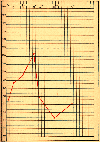
|
Fig. 21. Average quantities of milk yielded by each of
seven wet-nurses from October 1, 1895, to the end of
February 1896.
|
|
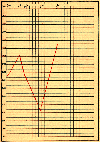
|
Fig. 22. Average quantities of milk furnished by each of
three wet-nurses from November 2, 1895, to the end of
February 1896.
|
|
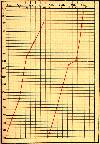
|
Figs. 23 and 24. Fig. 23, on the left, and Fig. 24, on
the right, show how the milk production of two wet-nurses
increased.
|
|
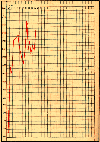
|
Fig. 25. The milk production of a wet-nurse varies with
the demands of her nurslings.
|
|

|
Fig. 26. The milk production of a wet-nurse varies
according to the number and the needs of her nurslings.
|
|
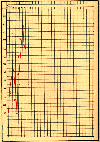
|
Fig. 27. The milk production of a wet-nurse varies
according to the number and the needs of her nurslings.
|
|
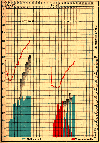
|
Fig. 28. Curves of twins. The first was nourished
exclusively by the mother (blue columns); the second was, at
the beginning, breast-fed by a wet-nurse (red columns). The
mother began also to suckle the second on the ninth day, and
on the fifteenth was able to nourish both unaided. The black
columns on the figure of the first twin represent the total
milk production of the mother; those on the figure of the
second twin indicate the amount it daily received from
mother and wet-nurse.
|
|
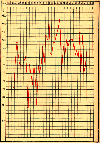
|
Fig. 29. Average daily quantities of milk furnished by
the wet-nurse Andr___ from the sixth to the fifty-sixth
week.
|
|
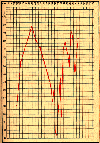
|
Fig. 30. Average daily quantities of milk furnished by
the wet-nurse Gail___ from the eighth to the fiftieth week.
|
|

|
Fig. 31. Average daily quantities of milk furnished by
the wet-nurse Capit___ from the eighth to the fifty-eighth
week.
|
|
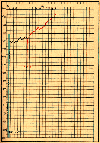
|
Fig. 32. Weakling whose weight was almost stationary.
Pepsin was given and his curve rose.
|
|
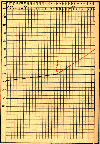
|
Fig. 33. Weakling whose weight was almost stationary.
Pepsin was given and his curve rose (only general outline of
curve shown).
|
|
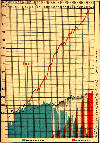
|
Fig. 34. Weakling whose weight did not increase
satisfactorily until pepsin was given. Suckled first by a
wet-nurse (blue columns), then by wet-nurse and mother, and
finally by mother alone (red columns).
|
|
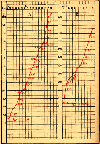
|
Fig. 35. A and B, curves of two young dogs reared on
artificially digested milk.
|
|

|
Fig. 36. Weakling whose weight was stationary.
Pre-digested milk was given, and the curve steadily rose. A,
curve per day; B, general outline of weekly curve.
|
|
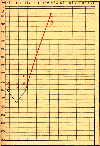
|
Fig. 37. Beneficial effect of pepsin in a weakling. Black
line, from birth to admittance to the department for
weaklings. Blue line, fed by a wet-nurse exclusively. Red
line, wet-nurse plus pre-digested milk.
|
|
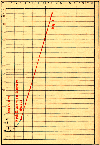
|
Fig. 38. General outline of curve, showing beneficial
effect of pre-digested milk.
|
|
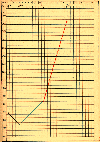
|
Fig. 39. Outline of curve to show effect of pre-digested
milk.
|
|
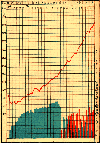
|
Fig. 40. Puny weakling first fed with the milk of a
wet-nurse (blue columns), the mother in the meantime
suckling a stronger infant in order to bring about the
establishment of her mammary secretion (red column). The
mother became capable of nursing her child unaided.
|
Return to The Nursling Contents Page
Created 2/5/97 / Last modified 2/5/97
Copyright © 1998 Neonatology on the Web / webmaster@neonatology.net


















